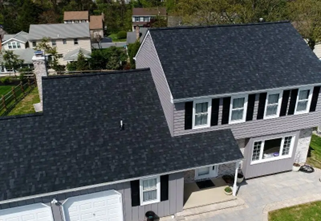
When you think about your roof, it might just seem like one big slab that protects you from the elements. But a residential roof is a well-coordinated system made up of several key components, all working together to keep your home safe, dry, and cozy. Let’s break down the eight main components that make up a residential roof system, so you can appreciate what’s above your head every day.
1. Roof Decking
The roof decking is the foundation of your roof. Typically made of plywood or oriented strand board (OSB), it forms the base layer that supports the rest of the roofing materials. It’s attached directly to the roof trusses and provides a surface for the underlayment and shingles to be installed on. Think of it as the sturdy backbone that keeps everything in place.
2. Underlayment
Before the shingles go on, there’s a crucial layer of protection that gets laid down first—the underlayment. This material, often made of felt or synthetic materials, acts as a moisture barrier. It helps prevent water from seeping into your home if the outer roofing layer is damaged. Consider this your roof’s first line of defense against the elements.
3. Shingles
Shingles are the visible outer layer of your roof that gives it its look and style. They come in various materials like asphalt, wood, metal, or even slate. Beyond aesthetics, shingles are your roof’s primary shield against weather, deflecting rain, snow, and UV rays. Asphalt shingles are the most common for residential roofs due to their affordability and durability.
4. Flashing
Flashing is like the unsung hero of your roof system. Made from metal (usually aluminum or galvanized steel), flashing is installed around roof features like chimneys, vents, and valleys. Its job is to direct water away from these vulnerable areas and prevent leaks. Without flashing, water could easily sneak into your home, causing damage.
5. Ventilation
Proper ventilation is essential for maintaining the health of your roof and your home. Roof vents, usually placed along the ridge or under the eaves, allow hot air and moisture to escape from the attic. This helps prevent problems like mold growth, ice dams, and even premature roof deterioration. Good ventilation is like your roof’s built-in air conditioning system—keeping things cool and dry.
6. Drip Edge
The drip edge is a thin strip of metal installed along the edges of the roof. Its job is simple yet vital: to keep water flowing away from the fascia and prevent it from getting under the shingles. It helps protect the underlying structure from water damage and rot. Without a drip edge, water could sneak under your roof and cause all sorts of issues.
7. Soffit
The soffit is the area underneath the roof overhang. It’s not just there for looks—it plays a crucial role in your roof’s ventilation system. The soffit allows air to flow into the attic, ensuring proper circulation. It also helps keep pests and moisture out, protecting your home from potential damage.
8. Fascia
The fascia is the board that runs along the edge of the roof, usually where the gutters are attached. It provides a finished look to the roof and helps support the bottom edge of the shingles. But beyond aesthetics, the fascia also serves as a barrier that protects the edge of the roof from the elements, keeping water, wind, and pests at bay.
Call Ferris Home Improvements
For over 20 years, Ferris Home Improvements has been a trusted name serving Delaware, and parts of Pennsylvania and Maryland. Whether you need roofing repair, window installations, or kitchen remodeling, our expert craftsmen are here to help. Contact us today to learn how we can help.
